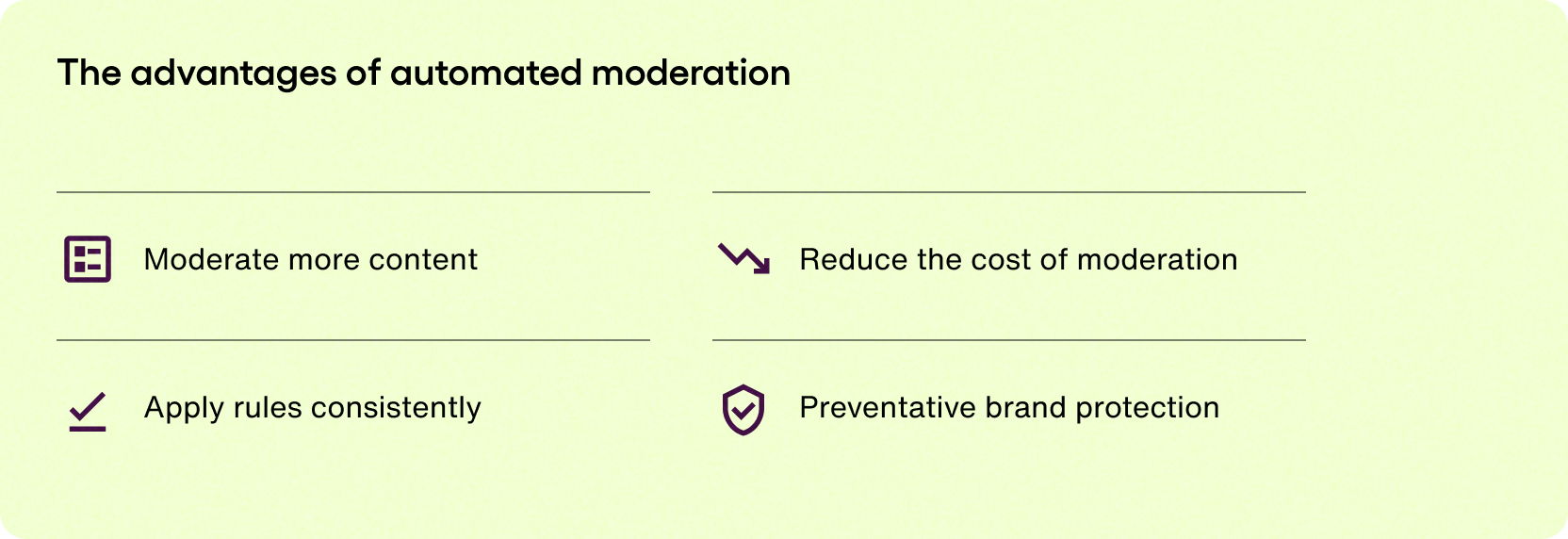How AI keeps content safe with automated moderation

Any app experience can be a social one with messaging. Adding social features is proven to grow user engagement and acquisition.
With any social experience comes the responsibility of building a community that is safe for all your users. For any business, moderating millions of messages by hand can be a daunting task — which is why many apps are now moving to automated moderation.
Imagine: you can automatically filter unwanted content, protect sensitive information, and regulate words or offensive images. It could save your business a massive amount of time, and protect your staff and users alike from the darker side of the online world.
Here’s a closer look at the technology and reasons why you should consider deploying automated moderation in your app.
What is automated moderation?
Automated moderation refers to moderation systems that scan UGC (user-generated content) and apply a set of rules created by the hosting platform.
For instance, some online communities automatically censor certain words that are deemed to be universally offensive. If a user tries to send a message or make a public comment that contains a banned term, the post is instantly removed.
Automated moderation can also apply to user management, such as limiting the number of messages any individual can post within a specific time frame or freezing an account for a particular amount of time after repeat offenses.
With the introduction of AI, auto-moderation systems' capabilities have been extended significantly. While these systems are still based on rules, they can now adapt to real-world scenarios.
The advantages of automated moderation

There are multiple benefits of adopting automated moderation, particularly for startups with limited resources and businesses that want to scale a social platform:
Moderate more content — Without the help of auto-moderation, platforms on the scale of Facebook, Instagram, and Twitter wouldn’t be manageable.
Reduce the cost of moderation — By handling the majority of moderation automatically, you don’t need to hire as many human content moderators.
Apply rules consistently — Human moderators sometimes make mistakes; by using automated systems, you ensure that rules and community guidelines are applied uniformly.
Preventative brand protection — Rather than taking down content that has already been posted, automated moderation allows you to intercept inappropriate content before it is sent.

Your app is where users connect.
Types of auto moderation
To understand how these benefits might apply to your business, you first need to know the capabilities of automated moderation. Here are some of the key features you will find in most moderation solutions today:
Automated content flagging
Perhaps the most basic form of automatic moderation is content flagging. This is where your system detects content that potentially goes against your guidelines, and flags it up for human review.
Every major social media platform today uses automated content flagging for text, images, and videos. Machine learning algorithms detect content that may be deemed inappropriate. This allows businesses to detect the vast majority of inappropriate content while still maintaining a human touch when applying the rules.
This is important because users can quickly become frustrated by fully automated moderation that is a little overzealous.
Intent recognition and natural language processing
While language filtering can prevent users from sharing offensive terms, it cannot detect the meaning of any given message. As such, users with bad intentions can simply remove specific words to bypass the filters.
The solution to this challenge is intent recognition or sentiment analysis. This is where your moderation system uses natural language processing algorithms to determine the intent behind every message and post, rather than simply looking for specific words.
When the system deems a message out of line, it can be automatically stopped and sent to the flagging system. Inevitably, some of these assessments will be incorrect — so human review is once again an essential part of the process.
Image and video moderation
While textual messages can be interpreted automatically using natural language processing, images and videos require a different form of content auto-moderation.
Machine learning has a big part to play here. Up-to-date auto-moderation systems use computer vision to detect the contents of images and videos, and they can pick up harmful content in audio tracks. As with other types of content, inappropriate uploads can be removed or flagged automatically.
Pre-moderation and post-moderation
There are essentially two models for moderating content on any platform. Pre-moderation screens new content before it is posted, while post-moderation allows content to be uploaded before it is checked.
In theory, pre-moderation is the better way to prevent users from sharing inappropriate, offensive, or illegal content. However, checking every post takes time, and that delay can completely disrupt the flow of a real-time conversation.
For this reason, post-moderation is often a better option if live chat is an important part of your app.
Sendbird’s tutorials for content moderation
AI is the next step for moderating content
Thus far, most automated content moderation systems have relied on simple filtering. But as social platforms continue to expand, businesses will need new smart moderation tools to maintain healthy digital communities.
Both the cause and potential solution for these challenges is artificial intelligence.
In the coming years, generative AI like ChatGPT and MidJourney will allow users to create content faster. Human content moderators cannot keep up without the assistance of AI-automated content moderation tools.
Artificial intelligence is already helping with natural language processing and automated image moderation. As datasets grow, these technologies will likely become more accurate and reliable.
Moreover, AI can be trained to perform some of the tasks previously performed by human moderators. This takes some time, but the pay-off is a massive reduction in the input required from your moderation team.
Automation of this kind could even improve the mental health of your workers. Studies show that moderators working on platforms such as Facebook and YouTube often suffer from PTSD after viewing the darkest types of online content.
For all the reasons mentioned, AI has a large part to play in the future of moderation.
Ways to use automated moderation
Returning to the present day, how can you utilize automated content moderation in your app? Here are three key ways to deploy the technology:
Profanity detection
In any open forum, language that is likely to offend some users should be avoided. A leading communications API platform like Sendbird allows you to set up profanity filters that can detect and remove hurtful comments automatically. If you prefer to assign chat moderation decisions to your team, you can also create a filter that flags up questionable posts for manual moderation. Our solution even allows you to create a dedicated dashboard for these tasks.
Community protection
You’re always likely to find scams and trolling on any platform where users can interact. It’s just an unfortunate fact of life. What counts is how you deal with the problem.
The top priority here is to protect your users. Your app should make it easy for people to report unwanted conversations and block other users causing problems.
Of course, reporting isn’t always enough. Users don’t necessarily realize when they are being lured into a trap, so it’s important to set up some preventative measures, as well.
Using Sendbird, you can create regex-based filters that detect the standard formatting of key personal information—such as an email address or a social security number. If you’re concerned about the more vulnerable members of your community, you can prevent people from sharing this kind of information through your app.
Enforce community guidelines
Effective online platforms don’t only moderate content to keep users safe. To provide a good user experience for everyone, creating and enforcing some community guidelines is usually necessary.
Two common areas of concern for social networks and messaging services are self-promotion and spam. If these types of content are not kept in check, they can quickly make your platform unusable.
To reduce the incentives for posting such content, some communities ban link sharing. If you decide to go down this path, you can easily set up link detection in Sendbird.
You can also use AI to anticipate unwanted behavior. When users interact for the first time, you can send them an automated message that includes the community guidelines you want them to follow. You could even send them a prompt to encourage a positive first interaction, such as introducing themselves or connecting with a friend.
Moderation AI + Chat API
If you add messaging features to your product, it’s essential to consider app moderation. Given the challenges of managing vast volumes of content, it makes sense to adopt a solution with moderation built in.
With Sendbird's chat API, you can add messaging and social features to your app with minimal effort. As importantly, our platform provides a range of tools for moderating content, clamping down on hate speech, and improving user safety.
We’re also introducing new AI tools allowing you to automate various aspects of your user experience.
Want to try it? Sign up today for a free trial and see how easy moderation can be.









